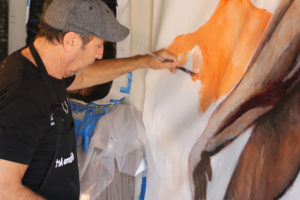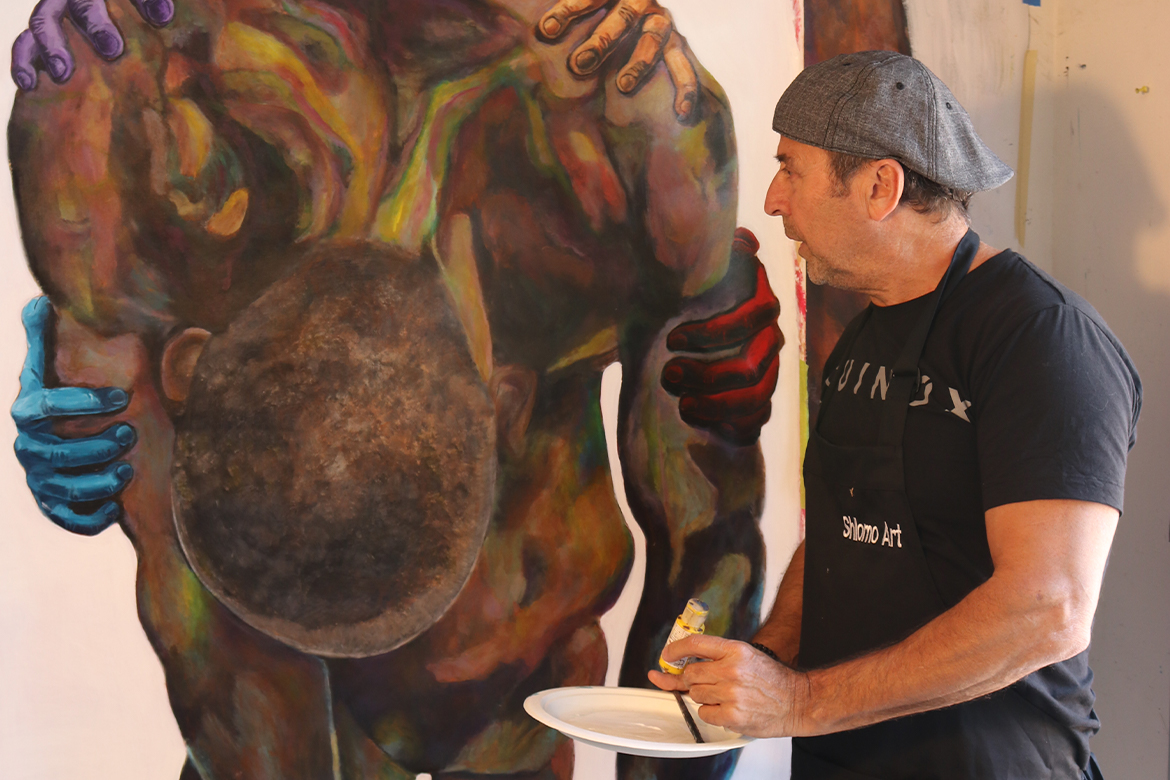One of the most essential factors that distinguishes a mediocre artist from a great one is the inspiration behind their work. It is fueled by their desire to convey the story that was the driving force for their creation — the one that inspired them to start painting, sculpting, or writing words and melodies to heartfelt tunes.
Meet Shlomo Tuvia, one of the Jewish community’s most intriguing and influential artists of our time. Residing with his family in the San Fernando Valley, Tuvia mostly works from his studio in Malibu. He has recently showcased his work in the LA Art Show at the LA Live complex located in downtown Los Angeles and has been selling his artwork with great success in Japan and the international Fine Arts website, Artsy. He hosts exhibitions in a wide range of galleries throughout Los Angeles, including the MRG Fine Art Gallery — and has been selected to showcase his work in one of Italy’s most renowned galleries in Rome, La Citta Eterna, this upcoming spring.
Sixty two year old Tuvia was born in Jaffa in the late 1950’s to the Keshet-Yom family. His parents were deaf by birth and as the older brother, he was responsible for taking care of the house and his younger brother, Reuven.
When he was just a year old the family moved to Rehovot and he grew up in what is now considered the neighborhood of the Yemenite Jews, Sha’arim Marmorek. He shared stories with me about the immense warmth and love he received from the community that embraced and welcomed him because of his parents’ disability. (At the time, discrimination and ongoing protests between Mizrahi Jews and Ashkenazi Jews in Israel was very common).

SHLOMO TUVIA
“The Yemenite Jewish community gave me a sense of direction and life that was as normative as possible. I grew up in one room where Dad, Mom, Reuven, and I slept. We had two sofa beds that were folded during the day, and then opened at night for us to sleep on. Although my parents were unable to hear or speak, they always managed to give us a lot of warmth and love.”
Shlomo, that doesn’t sound like a simple life for such a small child.
“Yes, by the age of five I learned to read and write because I had to manage the house. Letters from the municipality had arrived, along with electric and water bills that had to be paid, and my parents couldn’t handle them. They did not know their right from their left. As a little boy, I remember feeling ashamed as to why it was only my parents who couldn’t speak or hear even the simplest things like reading me a story — but my dad worked extremely hard to make a living and bring food to the table. Later on, he was wounded and retired.”
Tuvia would communicate with his parents through the paintings. “I would paint for mom and dad in order to express myself. If I wanted to talk to them about a decision made by the Israeli government, they would not even know what ‘government’ meant so we would call it the ‘state bosses’ and I would paint the Knesset in Jerusalem–and they recognized and understood what I meant. Or when I told them that former U.S. President Kennedy was murdered, I painted them an image of Kennedy and a gunshot – and that is how I expressed that he died. My parents did not know the difference between who’s who and what’s what.
If I wanted to share a story about my friends, I would have to draw their characters. To them, my friends were the ‘short guy,’ or the friend with the curls, or the tall one. I simply communicated everything with them through art.”
Tuvia told me that his love for painting began in the early years of school where he found an original and interesting way to publish his work. “Those years, classroom tables were made of wood. During our breaks, when all the students went out into the yard, I would draw on the tables and on some occasions, even stay after school and wait for everyone to leave so I could continue drawing. I wanted my work to be everywhere and would make pictures in the style of Picasso — with square faces and all sorts of different characters.”
Shlomo Tuvia arrived in the United States at the young age of twenty-one. He landed in Los Angeles and began working as a painter and artist. The buildings of Hollywood can easily tell the story of Shlomo’s early artistic influence, as well as many neighborhoods in the San Fernando Valley.
Recently, Tuvia began an artistic initiative that ultimately led to his grand recognition in the Los Angeles community. Body Art is a hands-on initiative that is geared towards the expression of emotions, mental state, and awareness through various body movements. His inspiration for this was drawn from the relationship he had with his parents who recently passed away. “I would mostly communicate with them through hand gestures and body movements which were a way emotion was expressed in my paintings. In recent years, I have also entered the world of Kundalini yoga and used the exercises as a way to enrich my work with a variety of movements. Sometimes my work portray a sense of calmness and movement, while other times sadness.”

SHLOMO TUVIA at work (Photo by: Elad Massuri)
Each of Tuvia’s paintings also expresses a different life ambition. His creation entitled “The Last One,” clearly portrays the desperate desire to quit smoking through the painting of a distorted and bent over man trying to hold a cigarette away from his body.
What would you say is the source of your inspiration?
“Everything, ranging from going to a museum to browsing the web and seeing the works of different artists and realizing that I can do much better. I’m also less connected to the world of abstract art and like art that is easy to understand and has meaning. The whole concept of painting reminds me of my parents – primarily my mother because she would always look at me when I painted as a young child and give me some feedback. Painting is my refuge – and in my opinion, it’s much better to do that versus going to a bar to drink.”
Translation by: Yael Sesnov
Shlomo Tuvia’s artwork can be found at this site: www.artsy.net/artist/shlomo-tuvia
His Instagram can be found here: www.instagram.com/shlomo_tuvia/


